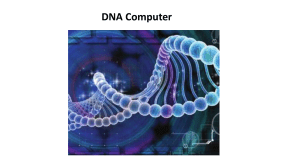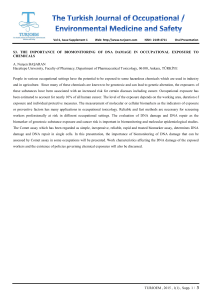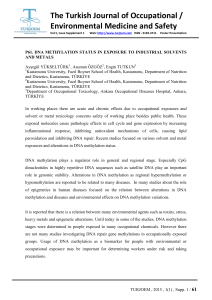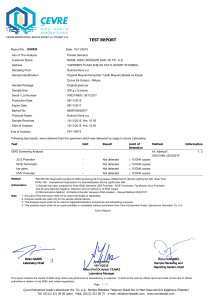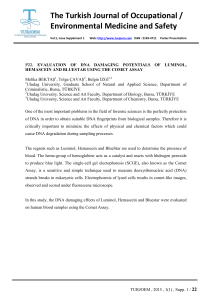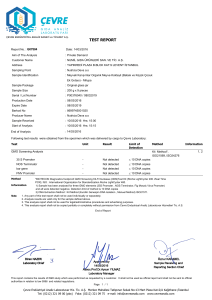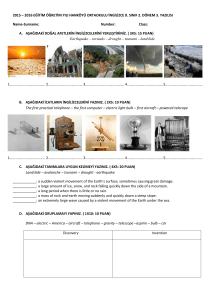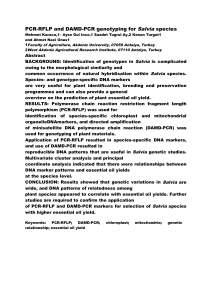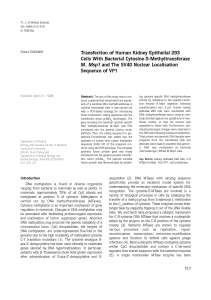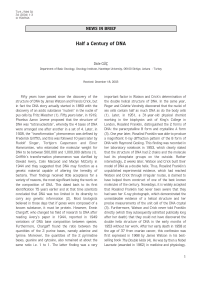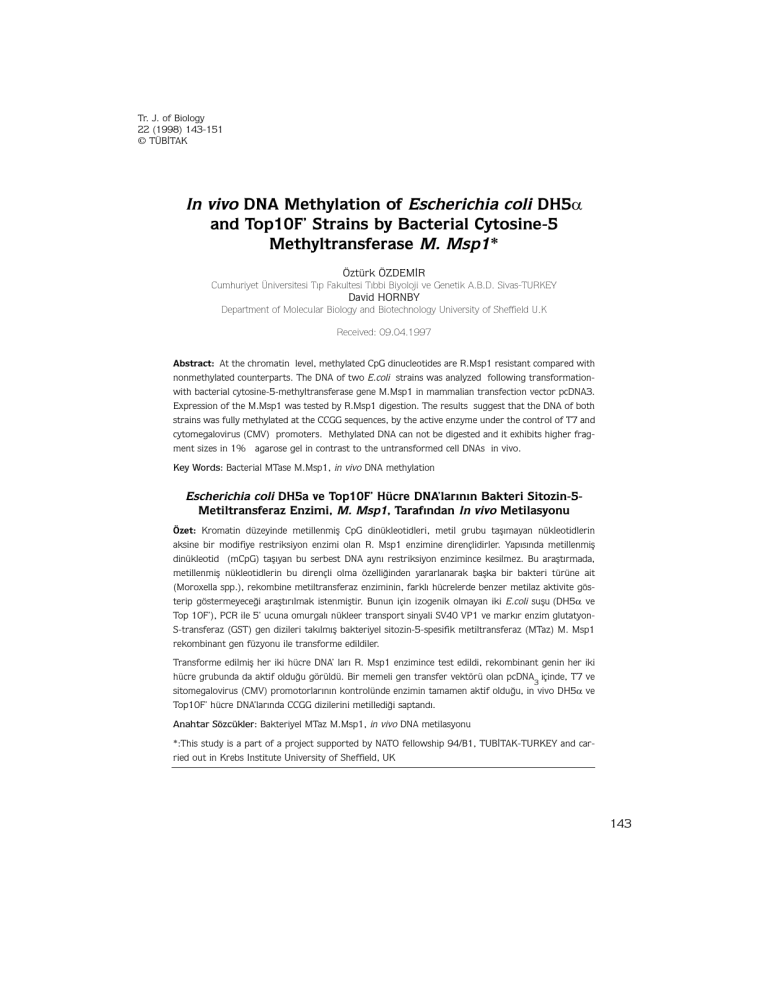
Tr. J. of Biology
22 (1998) 143-151
© TÜBİTAK
In vivo DNA Methylation of Escherichia coli DH5α
and Top10F’ Strains by Bacterial Cytosine-5
Methyltransferase M. Msp1*
Öztürk ÖZDEMİR
Cumhuriyet Üniversitesi Tıp Fakultesi Tıbbi Biyoloji ve Genetik A.B.D. Sivas-TURKEY
David HORNBY
Department of Molecular Biology and Biotechnology University of Sheffield U.K
Received: 09.04.1997
Abstract: At the chromatin level, methylated CpG dinucleotides are R.Msp1 resistant compared with
nonmethylated counterparts. The DNA of two E.coli strains was analyzed following transformationwith bacterial cytosine-5-methyltransferase gene M.Msp1 in mammalian transfection vector pcDNA3.
Expression of the M.Msp1 was tested by R.Msp1 digestion. The results suggest that the DNA of both
strains was fully methylated at the CCGG sequences, by the active enzyme under the control of T7 and
cytomegalovirus (CMV) promoters. Methylated DNA can not be digested and it exhibits higher fragment sizes in 1% agarose gel in contrast to the untransformed cell DNAs in vivo.
Key Words: Bacterial MTase M.Msp1, in vivo DNA methylation
Escherichia coli DH5a ve Top10F’ Hücre DNA’larının Bakteri Sitozin-5Metiltransferaz Enzimi, M. Msp1, Tarafından In vivo Metilasyonu
Özet: Kromatin düzeyinde metillenmiş CpG dinükleotidleri, metil grubu taşımayan nükleotidlerin
aksine bir modifiye restriksiyon enzimi olan R. Msp1 enzimine dirençlidirler. Yapısında metillenmiş
dinükleotid (mCpG) taşıyan bu serbest DNA aynı restriksiyon enzimince kesilmez. Bu araştırmada,
metillenmiş nükleotidlerin bu dirençli olma özelliğinden yararlanarak başka bir bakteri türüne ait
(Moroxella spp.), rekombine metiltransferaz enziminin, farklı hücrelerde benzer metilaz aktivite gösterip göstermeyeceği araştırılmak istenmiştir. Bunun için izogenik olmayan iki E.coli suşu (DH5α ve
Top 10F’), PCR ile 5’ ucuna omurgalı nükleer transport sinyali SV40 VP1 ve markır enzim glutatyonS-transferaz (GST) gen dizileri takılmış bakteriyel sitozin-5-spesifik metiltransferaz (MTaz) M. Msp1
rekombinant gen füzyonu ile transforme edildiler.
Transforme edilmiş her iki hücre DNA’ ları R. Msp1 enzimince test edildi, rekombinant genin her iki
hücre grubunda da aktif olduğu görüldü. Bir memeli gen transfer vektörü olan pcDNA içinde, T7 ve
3
sitomegalovirus (CMV) promotorlarının kontrolünde enzimin tamamen aktif olduğu, in vivo DH5α ve
Top10F’ hücre DNA’larında CCGG dizilerini metillediği saptandı.
Anahtar Sözcükler: Bakteriyel MTaz M.Msp1, in vivo DNA metilasyonu
*:This study is a part of a project supported by NATO fellowship 94/B1, TUBİTAK-TURKEY and carried out in Krebs Institute University of Sheffield, UK
143
In vivo Dna Methylation of Escherichia coli DH5α and Top10F’ Strains by Bacterial Cytosine-5 Methyltransferase
M.Msp1
Introduction
DNA methyltransferases (MTases) have long been regarded as an attractive model for studying DNA - protein interaction. Over 50 cytosine DNA MTases from organisms ranging from bacteria to mammals have been cloned and sequenced (1-3). DNA methylation is used by a wide
range of prokaryotes and eukaryotes for the marking of DNA sequences and regulation of gene
expression (including restriction-modification systems), DNA replication and repair. Methylation
of cytosine at carbon-5 of pyrimidine ring occurs at postreplication stage of DNA synthesis by
the activity of DNA methyltransferase (MTase) (4-6). Cytosine MTases transfer methyl groups
from the donor S-adenosyl-L-methionine to the C-5 position of target cytosine in specifically
recognized DNA sequences. It is obvious that DNA methylation is the most common form of DNA
postmodification in biological systems. Many studies have shown correlations between increased
gene expression and decreased DNA methylation (7-8). In mammalian cells, 3-5% of the cytosine residues in DNA are methylated. The haploid mammalian genome contains (5x107 CpG dinucleotides about 60% of which are methylated at the 5 position. Methylation patterns undergo
sweeping reorganization during gametogenesis and early development. In addition to CpG
methylation, plant DNA contains methylated bases in the trinucleotide sequence CpNpG, where
N can be A ,C,G or T (9). Bacterial MTases are usually found as a part of restriction-modification systems to activate in cell's defense against phage infection in prokaryotes. These
enzymes share a common protein architechture. Ten conserved motifs are normally found 1020 aa in length and a hypervariable sequence called TRD (T: threonine, R: arginine and D: aspartic acid) which is located between motifs VIII and IX (10). Two major classes of DNA MTase exist
in nature. First, methylates a pyrimidine ring carbon and forms C-5 methylcytosine (M.Msp1
and M.Hha I). The second class methylates exocyclic nitrogens and forms either N4 - methylcytosine (M.Pvu II) or N6 -methyladenine (M.TaqI) (11-13). HhaI and HpaII DNA MTases bind DNA
mismatches which methylate uracil and block DNA repair (14). Bandaru et al. proposed that
HpaII MTase was mutagenic in E. coli. The presence of the enzyme in E. coli causes a substantial increase in C to T mutations at CG sites (15). M.SssI and M.HhaI MTases reveal extensive
interactions with the substrate DNA backbone. The two structurally related enzymes display
similar specific and nonspecific contacts with DNA while bound to their target sequences (16).
Sites for cytosine methylation are known as hot spots for cytosine to thymine mutations (10).
It is our claim that because of their biological importance, their sequence specificity and reaction
similarity, the C- 5 MTases will be the subject of many studies in the near future.
We aimed to study the gene encoding the above mentioned MTase M.Msp1 whether it is
active or inactive with glutathion-S-transferase (GST) and mammalian nuclear localisation transport sequences (NLS) which were fused to the 5' end of gene. For this purpose, the recombinant plasmid, encoding the bacterial M.Msp1 protein and which was used to transform different E. coli strains and expression level of the fusion product, was analysed under the control of
T7 and CMV promoters. It is reported here, that the protein was found to be fully active and
is able to methylate the CCGG sequences of the plasmid encoding the recombinant M.Msp1 in
E.coli strains used .
144
Ö. ÖZDEMİR, D. HORNBY
Material and Methods
Oligonucleotides and PCR Amplification
Synthesis of all oligonucleotides was performed on a model 381 DNA synthesiser by the biomolecular synthesis service of the Krebs Institue, Sheffield, U.K. About 100 ng bacterial
M.Msp1 genomic DNA was served as template and the primers were;
Top strand,
52 mer 5'-CGCG AAGCTT CATAAG GCGGGGTATTTTGCGTTTT CCCCTATACTAGGTTAT-3'
HindIII
NdeI
NLS
GST
Bottom strand (AWMSP3 : forward primer to 3' end of M.Msp1 sequence contains EcoRI
recognation and stop sites),
39 mer 5'- CGCG GAATTC TTA AACGAATTCTAATTCAAAGTTTTCTT -3'
EcoRI Stop
M.Msp1
PCR amplification reactions contained 2 µl of each primer (0.5 µM), 1µl template DNA (100
ng), 1µl dNTP's (200 µM for each), 2 µl MgCl2 (2mM), 5 µl of 10X Taq DNA polymerase buffer
{ (500 mM KCL, 100 mM Tris (pH:9.0 at 25 °C), 1 per cent TritonX-100)} and 1µl Taq DNA
polymerase (2 Units), (Promega Biotec) were performed in a final volume of 50 µl . PCRs were
carried out using the Thermal Cycler Techne Model HL-1. Initial template denaturation was
programmed for 1.5 min at 94 °C. The cycle procedure was programmed as follows: 2 min at
50(C (annealing), 3 min at 72 °C (extention ) and 1 min at 94 °C (denaturation). Thirty cycles
of the profile was run and the final extention step was increased to 10 min.
Bacterial Strains and Chemicals
Escherichia coli strains used for transformations were;
DH5α: [ (ϕ 80 d lac Z∆ M15 , rec A1 gyr A96, thi -1 , hsd R17 ( rK-, mK+ ) sup E44 , rel A1,
deoR , ∆ (lac zya - argF ), U169 ) ]. and
Top10F': F'(lac Tn10 (TerR )] mcr ∆D (mcr- hsd RMS -mcr BC ) ϕ 80 lac Z∆ m15, ∆lac X74,
deoR , recA1,ara D139 ∆ (ara-leu ) 7697 gal U , gal K, rps L end A1 nup G.
Both strains were purchased from New England Biolabs (NEB) and Invitrogen respectively.
Ultrapure deoxynucleotide solutions were from Pharmacia and ribonuclease A was obtained
from Worthington Biochemical Co. DNA weight standards were obtained from NBL Gene Science
Ltd. and NEB. Other plasmid DNAs, enzymes and chemicals were obtained from various commerical sources and used according to the manifacturer's instructions.
145
In vivo Dna Methylation of Escherichia coli DH5α and Top10F’ Strains by Bacterial Cytosine-5 Methyltransferase
M.Msp1
Construction of Plasmids
The aim of this study was to construct a plasmid that would direct the expression of a
recombinant bacterial DNA MTase enzyme in cultered cells. A PCR based strategy was carried
out for introduction of three component coding sequences into the mammalian transfection vector pcDNA3 (Invitrogen). First, the gene, encoding the bacterial cytosine-5 specific DNA MTase
M.Msp1 was introduced into the general cloning vectors pMTL23 and pNRT2. To this construct
the coding sequence for glutathion-S-transferase was added followed by a vertebrate nuclear
localisation SV40 VP1 sequence both by PCR based methodology. The complete fusion protein
encoding gene was finally introduced into the general purpose transfection vector pcDNA3.
Cell Culture and Transformation
The standard method for preparing competent cells was a modification of the calcium chloride procedure (17). A single colony of E. coli strains (DH5α and Top10F'), which was inoculated into 5mls LB medium and incubated overnight at 37 °C. 50 µl of this culture, was then
transferred into a further 5 mls of LB and grown until the OD260 of the culture reached 0.6
(~2 hours ). 1.5 ml samples were then centrifuged at 12.000 rpm in a microcentrifuge for 2
minutes. The supernatant was removed and the bacterial pellet resuspended in 50 µl of ice-cold
CaCl2 (50 mM) solution. After 2 minutes centrifugation, the supernatant was removed and 100
µl of 50 mM CaCl2 solution was added and at the same time between 5-10 µl of a ligation
mixture or less than 100 ng (~ 1(l ) of a recombinant plasmid DNAs with bacterial M.Msp1 gene
fusion were added to the competent cells, which were mixed gently and incubated on ice for 20
minutes. The cells were then heat shocked at 42 °C for 2 minutes and chilled by returning the
suspension immediatelly onto ice. 1ml LB medium was added to each sample and subsequently incubated at 37 °C for 1 hour. Each sample was then recentrifuged at 12.000 rpm in a
microcentrifuge for 2 minutes, and pellet was resuspended in a volume of 200 µl of LB and
plated out onto the appropriate media and antibiotics. DH5α cells were plated out in agar plates
containing LB medium (10 gr tryptone+5 gr yeast exract+10 gr NaCl in 1 lt distiled water) with
ampicillin (2 µg/ml) and Top10F'cells were plated out in agar plates containing LB medium with
ampicillin (2 µg/ml) and neomycin (40 µg/ml).
Preparation of DNA from Transformed Cells
Genomic and plasmid DNAs from transformed DH5α and Top10F' were isolated from 1.5500 mls of liquid LB culture following alkaline lysis method described in Sambrook et al. (18).
Recombinant bacterial cultures were grown to late log phase in LB medium with suitable antibiotics and the cells were harvested at 5000 g in a Sorvall centrifuge (GS3 rotor ) for 10 minutes
at 4 °C. The cells were then washed in solution I (0.184g/ml CaCl2, 0.125 M Hepes, pH: 7.15)
and 2ml of freshly prepared solution of lysozyme [100 mg lysozyme and 100 µl Tris (1M) and
10 ml H2O]. Suspensions were subsequently extracted with phenol-chloroform three times, followed by one-time ice-cold ethanol precipitation. DNA was resuspended in an 40 µl volume of
TE buffer (10 mM Tris.Cl, 1mM EDTA, pH : 8.0 ). Any further purification of plasmid DNA was
146
Ö. ÖZDEMİR, D. HORNBY
carried out by adsorption onto glass beads.
Restriction Activity Assay
Restriction digestion was performed by incubating 1µg DNA from transformed and control
group cells in a total volume of 20 µl with 10-20 units of restriction enzyme. Digests were
carried out at the suppliers recommended temperatures (usually 37 °C ) for 2-24 hours, using
specific buffers supplied with the enzymes. The restriction patterns were then analyzed by 1 %
agar gel electrophoresis.
Methylation Activity Assay
As a control pUC19, and recombinant plasmids that include NLS +GST + M.Msp1 gene were
digested with R.Msp1 and R.HpaII for detection of activity of recombinant gene in E.coli
strains. Digestion mixture (20 µl) included; 5 µl plasmid DNA + 2 µl R.Msp1 or R.HpaII restriction endonuclease ( RE) buffers + 2 µl of RNase (10 µl/ml) +1µl R.Msp1 or R.HpaII RE + 9µl
distilled water. The reaction mixture was incubated at 37 °C for 3 hours. Bacteriophage λ DNA
digested with HindIII and EcoRI was used as DNA molecular weight standards and unmethylated pUC19 DNA, transformed DH5α and Top10F' plasmid DNAs were spotted onto 1% agar
gels and stained with ethidium bromide (EtBr), (4 µg/ml ). The amount of DNA present was
quantified by comparing the UV induced fluorescence emitted by EtBr molecules intercaleted
into the sample DNA with that of a series of markers spotted onto the same gel .
Results
In order to establish the effect of bacterial cytosine-5 M.Msp1 MTase on DH5α and Top10F'
cells DNA, we have constructed a fusion of a bacterial cytosine-specific DNA MTase with a vertebrate nuclear targeting signal (NLS-SV40 VP1 ) and the marker enzyme glutathione-S-transferase (GST). Approximately 100 ng of pNRT2 encoding M.Msp1 gene as template and a 52
mer top strand, a 39 mer bottom strand as primers were used and PCR was set up according
to the protocol which was outlined in the expand long template PCR system package (Techne)
and explained in materials methods (Figure 1).
These DNA methyltransferase genes were separately cloned into the nonisogenic E.coli
strains DH5α and Top10F' respectively. Transformed and control group colonies were selected
with appropriate antibiotics (Figure 2).
These recombinant plasmids were stably maintained under selective growth conditions.
DNA methylation was monitored at different times after induction by determining the susceptibility of the DNA to R.Msp1 digestion. After isolation of small scale (mini- prep) plasmid DNAs,
from transformed E.coli strains that included NLS+GST+M.Msp1 recombinant gene, were
digested with R.Msp1 for detection of methylation activity of fusion protein. This showed that
production of bacterial methyltransferase can be expressed by the T7 and CMV promoters. The
147
In vivo Dna Methylation of Escherichia coli DH5α and Top10F’ Strains by Bacterial Cytosine-5 Methyltransferase
M.Msp1
fusion protein was found fully active and able to methylate CCGG sequences of the plasmids
encoding the M.Msp1 in E.coli strains used. The multicopy plasmid DNAs appeared to be completely methylated. We always observed uncut, high-molecular-weight DNA fragments on 1 %
agar gels (Figure 3 and 4).
HindIII
KpnI
BamHI
EcoRI
EcoRV
NotI
XhoI
XbaI
XhoI EcoRI
p CMV
MspI
ori
pOZT3
4700 bps
T7
Sp6
pCDNA3
BGH
5400 bps
BamHI
1
GST
amp
NLS
amp
2
3
SV40
Neo
NdeI
HindIII
DIGEST WITH HindIII/XhoI
LIGATION
HindIII
NdeI
EcoRI
XhoI
MspI
Figure 1.
BGH
SV40
Neo
amp
BamHI
pCMV T7 NLS GST
PCR Product Lane 1:HindIII and EcoRI digested ( DNA marker Lanes 2-3 : ( 2000 bps, NLS+ GST+ M.Msp1
gene fusion
Discussion
Approximately 90% of methylated Cs is followed on its 3' side by a G residue. Conveniently,
this sequence forms part of the recognition sequence CCGG for two restriction enzymes
R.Msp1 and R.HpaII which differ in their ability to digest in this sequence when the C is methylated. Hence, if DNA is digested with either R.Msp1 and R.HpaII, both enzymes will give the
same pattern of bands only if all the C residues within the recognition sites are unmethylated
(19).
We were able to express monospecific (enzyme modifying a single DNA sequence) cytosine5 DNA MTase at high levels in two E.coli strains as functional fusions with glutathione-S-transferase and vertebrate nuclear targeting signal SV40 VP1. First we constructed the bacterial
cytosine specific DNA M.Msp1 MTase gene fusion including a nuclear localisation signal and glutathione-S- transferase and placed it under control of the T7 and CMV promoters (Figure 1).
148
Ö. ÖZDEMİR, D. HORNBY
1
3
4
5
6
7
8
9
10
E.coli DH5α and Top10F' cells were transformed with PCR product (M.Msp1 gene fusion ) and plated
out in LB medium and selected with ampicillin for DH5α, ampicillin and neomycin for Top10F'. After mini
- prep DNA isolation, DNAs were digested with Hind III and EcoRI restriction endonucleases for selection
of fragments carrying the fusion gene (~ 2000 bps). Lanes Lane 1, 2 and 3 : Positive DH5α colonies
Lane 4 :λ DNA digested with Hind III and EcoRI Lanes 5, 7, 8, 9 and 10 : Positive Top10F' colonies
Lane 6 : Negative Top10F' colony
1
2
3
Figure 2.
2
Figure 3.
Agar gel electrophoresis (1%) of ethidium bromide stained plasmid DNA from E.coli DH5α cells transformed
with bacterial cytosine -5- specific DNA MTase M.Msp1 gene fusion .Lanes Lane1: Transformed cells' DNA
digested with 10 U of R.Msp1. DNAs were resistant to the enzyme digestion and no fragmentations was
found Lane 2 : HindIII and EcoRI digested λ DNA marker Lane 3 : pUC19 plasmid DNA digested with 10 U
of R.Msp1.
After transformation of and establishment in two different non-isogenic E.coli cells, with the
PCR product of the fusion genes construct, we have found that genes with CpG islands have a
significant probability of becoming inactivated by methylation. The results indicate that the primary cause of preferential cutting is specific methylation of the CCGG sites in both strains.
Expression of the M.Msp1 gene fusion was tested by the cognate restriction enzyme R.Msp1.
Enzyme was active in both strains and methylated DNA could not be cut. Methylated DNA exhibited higher fragment sizes in 1% agar gel (Figure 3 and 4). Resistance to R.Msp1 digestion
appeared to require at least 8 hours to achieve sufficient methylation to yield high-molecular149
In vivo Dna Methylation of Escherichia coli DH5α and Top10F’ Strains by Bacterial Cytosine-5 Methyltransferase
M.Msp1
1
2
3
4
weight protected fragments.This result suggests that methylation is non-random and certain
large regions are inaccessible to bacterial C-5 MTase action within the two E.coli DH5α and
Top10F' strains. Therefore, foreign MTase genes with regulated expression and vertebrate
nuclear targeting signal SV40 VP1 could be useful as an in vivo probe to test gene expression
and chromatin organization.
Figure 4.
Annealing profiles of transformed E.coli Top10F' and untransformed pUC19 plasmids DNA digested with 10
U of R.Msp1. The bacterial cytosine-5 MTase M.Msp1 fusion protein was active in all transformed strains
and prevented the DNA fragmentation contrary to the restriction activity of cognate enzyme R.Msp1(which
can not cleave if the external cytosine is methylated in its recognition site CCGG ). Lanes Lanes 1 and 4 :
Transformed E.coli Top10F' plasmid DNAs , not fragmentation. Lane 2: HindIII and EcoRI digested λ DNA
marker. Lane 3 : pUC19 plasmid DNA digested with 10 U of R.Msp1, high fragmentation.
References
1.
Razin A , Riggs AD : DNA methylation and gene function. Science 210: 604 - 610, 1980.
2.
Cheng X, Kumar S, Posfai JW and Roberts RJ : Crystal structure of the HhaI methyltransferase complexed with
S - adenosyl - L - methionine . Cell 74: 299 - 307 ,1993.
3.
Wu JC and Santi DV : Kinetics and catalytic mechanism of HhaI methyltransferase. J Biol Chem 262 : 47784786, 1987.
4.
Antequera F, Boyes J and Bird A : High levels of de novo methylation and altered chromatin structure at CpG islands
in cell lines . Cell 62: 502 -514, 1990.
5.
Boyes J, Bird A : DNA methylation inhibits transcription indirectly via a methyl CpG binding protein . Cell
64:1123 -1134 ,1991.
6.
Brandeis M, Ariel M and Cedar H : Dynamics of DNA methylation during development. BioEssays 45: 709-713,
1993.
7.
Sturm K , Taylor JH : Distrubution of 5- methylcytosine in DNA of somatic and germline cells from bovine tissues.
Nucl Acids Res 9: 4537-4546, 1981.
150
Ö. ÖZDEMİR, D. HORNBY
8.
Laird PW, Grusby LJ, Faxeli A, Dickinson SL, Jung WE, Li E, Weinberg RA and Jaenisch R : Suppression of intestinal neoplasia by DNA hypomethylation . Cell 81: 197-205, 1995.
9.
Clark SJ, Harrison J and Frammer M : CpNpG methylation in mammalian cells. Nature Genet 10: 20-27,1995.
10.
Gabbara S Sheluho D and Bhagwat A : Cytosine methyltransferase from E.coli in which active site cysteine is
replaced with serine is partially active. Biochem J(in press ).
11.
Wronski MA von , and Brent TP : Effect of 5-azacytidine on expression of the human DNA repair enzyme O6methylguanine - DNA methyltransferase . Carcinogenesis 15: 577-582, 1994.
12.
Gabbara S, and Bhagwat A : The mechanism of inhibition of DNA (cytosine-5- ) methyltransferase by 5-azacytidine
is likely to involve methyltransfer to the inhibitor. Biochem J 307 : 87-92, 1995 .
13.
Lauster R, Trautner TA, Noyer-Weinder M: Cytosine-specific type II DNA methyltransferase. A conserved enzyme
core with variable target-recognizing domains. J Mol Biol 206: 305-312 , 1989.
14.
Yang AJ, Shen JC, Zingg JM, Mi S, and Jones PA: HhaI and HpaII DNA methyltransferases bind DNA mismatches,
methylate uracil and block DNA repair. Nucl Acids Res 23 (8) : 1380-1387, 1995.
15.
Bandaru B, Wyszyski M, and Bhagwat A : HpaII methyltransferase is mutagenic in E.coli J of Bacteriol 177 (10):
2950-2952 ,1995.
16.
Renbaum P, and Razin A : Footprint analysis of M.Sss1 and M.HhaI methyltransferases reveals extensive interaction with the substrate DNA backbone . J Mol Biol 284: 19-26 , 1995.
17.
Chen C and Okoayama H: High efficiency transformation of mammalian cells by plasmid DNA. Mol Cell Biol 7:
2745, 1987.
18.
Sambrook J, Fritsch EF, Maniatis T : Edition 2 ( Molecular Cloning, A laboratory manuel (Cold Spring Harbor
Laboratory Press, Cold Spring Horbor 1989.
19.
Ayteí J, Goímez GG, and Hegardt FG : Methylation of regulatory region of the mitochondrial 3-hydroxy-3-methylglutaryl-CoA syntase gene leads to its transcriptional inactivation . Biochem J 295: 807-812, 1992.
151

